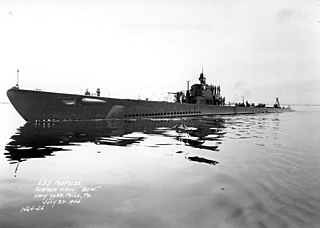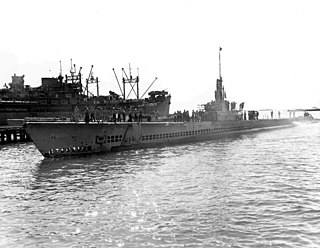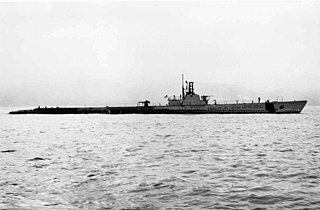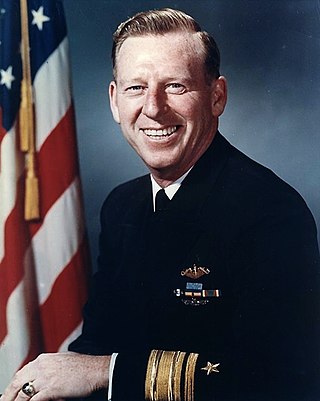
The Gato class of submarines were built for the United States Navy and launched in 1941–1943. Named after the lead ship of the class, USS Gato, they were the first mass-production U.S. submarine class of World War II.

USS Gato (SS-212) was the lead ship of her class of submarine in the United States Navy. She was the first Navy ship named for the common name used for a number of species of catshark. She was commissioned only days after the declaration of war and made thirteen combat patrols during World War II. She survived the war and spent the post-war period as a training ship before being sold for scrapping in 1960.

USS Dace (SS-247), a Gato-class submarine, was the first submarine of the United States Navy to be named for any of several small North American fresh-water fishes of the carp family.

USS Corvina (SS-226), a Gato-class submarine, was the only ship of the United States Navy to be named for the corvina.

USS Stickleback (SS-415), a Balao-class submarine, was named for the stickleback, a small scaleless fish.

USS Capelin (SS-289), a Balao-class submarine, was the only ship of the United States Navy to be named for the capelin, a small fish of the smelt family. She is credited with having sunk 3,127 gross register tons of shipping on her single war patrol.

USS Herring (SS-233), a Gato-class submarine, was the only ship of the United States Navy to be named for the herring.

USS Shark (SS-174) was a Porpoise-class submarine, the fifth ship of the United States Navy to be named for the shark.

USS Darter (SS-227), a Gato-class submarine, was the first ship of the United States Navy to be named for the darter.

USS Flier (SS-250) was a Gato-class submarine, was the only ship of the United States Navy to be named for the flier.

USS Cuttlefish (SC-5/SS-171), a Cachalot-class submarine and one of the "V-boats," was the second ship of the United States Navy to be named for the cuttlefish. Her keel was laid down by Electric Boat Company in Groton, Connecticut. She was launched on 21 November 1933 sponsored by Mrs. B. S. Bullard, and commissioned on 8 June 1934, Lieutenant Commander Charles W. "Gin" Styer in command. Cuttlefish was the first submarine built entirely at Electric Boat's facility in Groton, Connecticut; construction of previous Electric Boat designs had been subcontracted to other shipyards, notably Fore River Shipbuilding of Quincy, Massachusetts. Four Peruvian R-class submarines had previously been finished in Groton, using material from cancelled S-boats salvaged from Fore River.

USS Cavalla (SS/SSK/AGSS-244), a Gato-class submarine, is a submarine of the United States Navy named for a salt water fish, best known for sinking the Japanese aircraft carrier Shōkaku.

USS Porpoise (SS–172), the fifth United States Navy ship to bear her name, was the lead ship of her class of submarines.

USS Lionfish (SS-298), a Balao-class submarine, was the only ship of the United States Navy named for the lionfish, a scorpaenid fish native to the Pacific and an invasive species found around the Caribbean. She was designated a National Historic Landmark in 1986, and is now on display at Battleship Cove in Fall River, Massachusetts.

USS Cero (SS-225), a Gato-class submarine, was the first submarine and second ship of the United States Navy to be named for the cero.

USS Haddock (SS-231), a Gato-class submarine, was the second submarine of the United States Navy to be named for the haddock, a small edible Atlantic fish related to the cod. A previous submarine had been named Haddock (SS-32), but was renamed K-1 prior to her launching, so Haddock (SS-231) was the first to actually bear the name.

USS Muskallunge (SS-262), a Gato-class submarine, was a ship of the United States Navy named for the muskallunge.

USS Capitaine (SS/AGSS-336), a Balao-class submarine, was a ship of the United States Navy named for the capitaine, a brilliantly colored fish inhabiting waters of the Atlantic Ocean from North Carolina to Panama.

USS Queenfish (SS/AGSS-393), was a Balao-class submarine, the first ship of the United States Navy to be named for the queenfish, a small food fish found off the Pacific coast of North America.

Eugene Bennett Fluckey, nicknamed "Lucky Fluckey", was a United States Navy rear admiral who received the Medal of Honor and four Navy Crosses during his service as a submarine commander in World War II.




















